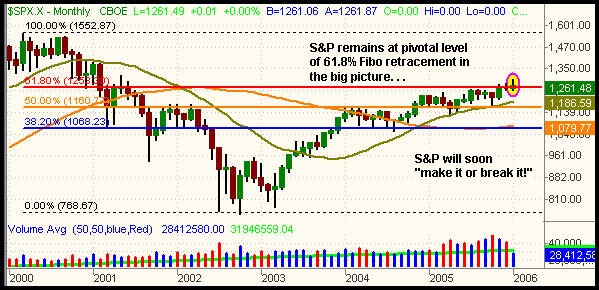Here’s what may attract buyers this week
A wave of negative corporate earnings reports finally took its toll on the markets, as stocks plummeted across the board last Friday. The Nasdaq Composite plunged 2.4%, the Dow Jones Industrial Average 2.0%, and the S&P 500 1.8%. Even small and mid-cap stocks were hit by the selloff this time. The Russell 2000 Index fell 1.5% and the S&P 400 dropped 1.6%. Although the steep losses were bad for traditional long-term investors, the session provided many opportunities for short-term traders because the major indices trended steadily lower throughout the entire session and finished at their intraday lows.
On January 19, the S&P and Nasdaq rebounded from the prior session’s “distribution day” by advancing on higher volume, but turnover surged even higher in last Friday’s selloff, countermanding Thursday’s bullish “accumulation day.” Total volume in the NYSE spiked 18% higher, while volume in the Nasdaq was 1% higher than the previous day’s level. It was the highest volume day in the NYSE since April 15, 2005, and was a whopping 35% above the 50-day average daily volume level in the Nasdaq. Although the Nasdaq’s volume increase was modest on Friday, remember that volume had already risen 31% on the January 18 “distribution day” and then 1% more the following day. In the Nasdaq, there have been six “accumulation days” and only two “distribution days” this month. However, there has only been one day of higher volume gains (accumulation) within the past six sessions. Conversely, both “distribution days” occurred within the past three sessions. This recent shift in the underlying volume trend is a key warning sign to astute bulls.
Because the S&P, Nasdaq, and Dow each closed below their January 18 lows, aggressive bets on the long side of the market are now off! The January 10 breakout to a new 52-week high in the Dow has failed and the daily chart is now beginning to look pretty ugly. The Dow’s 213-point slide on Friday caused the index to close below its 50-day moving average for the first time since October 28, 2005. It was also the Dow’s lowest closing price since November 10. But the most bearish thing about the Dow was the huge volume surge that corresponded with the selloff.
(
DIA |
Quote |
Chart |
News |
PowerRating), the ETF that mirrors the price of the Dow, spiked to nearly 3 times its average daily volume on Friday. It was DIA’s second highest volume day since May of 2004 (only barely edged out by the volume of October 12, 2005):

The daily charts of the S&P 500 and Nasdaq Composite look a little better than the Dow, but could easily fall apart if they fail to hold support of their 50-day moving averages. Interestingly, both indices closed last week right at their 50-day MAs, a critical level that should attract institutional buying interest. If it doesn’t, we could be in for some heavy selling in the coming week. We will be closely watching if institutional buyers step up to the plate in the coming days, as this is critical for the broad market to hold up in the short-term.
In the beginning of January, we discussed how the S&P 500 was entering the new year at pivotal support/resistance of its 61.8% Fibonacci retracement from the year 2000 high down to the 2002 low. In the January 17 issue of The Wagner Daily, we illustrated how the S&P had broken out above that resistance level on its monthly chart, but cautioned that we were only mid-way through the month. Based on last Friday’s bearish action, it seems that our
caution was certainly warranted. If the S&P were to finish the month at its current level, it would form a bearish “inverted hammer” candlestick on the monthly chart, although it would still be eight points above the 61.8% Fibonacci retracement of 1,253:

As we mentioned in the first issue of the new year, we continue to feel that 2006 will be a rather volatile year in the stock markets. After two years of relatively calm price action and a slow drift higher, we feel the 61.8% Fibonacci retracement will soon force the S&P to “make it or break it.” Whether or not the S&P finishes the current month above that 1,253 area will likely be a big determinant of the trend for the remainder of the year. In the short-term, expect the influx of upcoming earnings reports to continue having a big impact on the market action. If you’re long, keep those stops in place and follow your plan. Most importantly, remember to trade what you see, not what you think!
Open ETF positions:
Long half
(
PPH |
Quote |
Chart |
News |
PowerRating), long
(
PGJ |
Quote |
Chart |
News |
PowerRating) (regular subscribers to The Wagner Daily receive detailed stop and target prices on open positions and detailed setup information on new ETF trade entry prices. Intraday e-mail alerts are also sent as needed.)
Deron Wagner is the head trader of Morpheus Capital Hedge Fund and founder of Morpheus Trading Group (morpheustrading.com), which he launched in 2001. Wagner appears on his best-selling video, Sector Trading Strategies (Marketplace Books, June 2002), and is co-author of both The Long-Term Day Trader (Career Press, April 2000) and The After-Hours Trader (McGraw Hill, August 2000). Past television appearances include CNBC, ABC, and Yahoo! FinanceVision. He is also a frequent guest speaker at various trading and financial conferences around the world. For a free trial to the full version of The Wagner Daily or to learn about Deron’s other services, visit morpheustrading.com or send an e-mail to deron@morpheustrading.com
.
